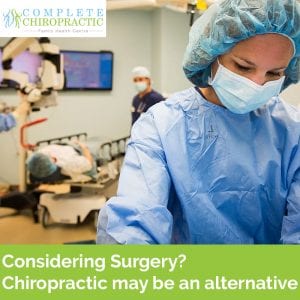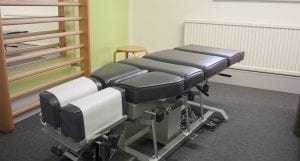At Complete Chiropractic, we’re not anti-surgery, nor are we in any way against the medical establishment – modern medicine does amazing things for people every day and has extended our length and quality of life immensely over the last few decades. What does concern us, however, is the speed at which people today jump to a surgical “quick fix” solution for common problems, such as lower back pain. While any doctor will, of course, recommend that non-surgical approaches are tried first, there’s an increasing tendency today for people to go “under the knife” for that quick-fix solution.
Lumbar decompression surgery
Probably the most common surgery carried out for back pain, sciatica and the management of conditions such as a slipped disk or injury is lumbar decompression. There are three main approaches to decompression -these are:
- laminectomy – where a section of bone is removed from 1 of your vertebrae to relieve pressure on the affected nerve
- discectomy – where a section of a damaged disc is removed to relieve pressure on a nerve
- spinal fusion – where 2 or more vertebrae are joined together with a section of bone to stabilise and strengthen the spine
There’s no question that in some cases, these approaches can be life-changing – restoring mobility and quality of life to patients for whom nothing else has worked, however, like any surgery there are some significant risks to keep in mind.
Lumbar surgery – potential complications
As with any surgery, there are complications associated with lumbar surgery – these include:
Continuing symptoms
Perhaps the most often overlooked risk of surgery is the possibility that put bluntly, it won’t work. Lumbar decompression surgery is generally effective in relieving symptoms such as leg pain and numbness. However, some people continue to have symptoms after surgery or develop symptoms again within a few years of surgery.
Recurrent symptoms can be caused by a weakened spine, another slipped disc or the formation of new bone or thickened ligament that puts pressure on your spinal cord. Scarring around the nerves can also sometimes develop after surgery, which can cause similar symptoms to nerve compression.
Infection
In terms of the surgery itself, one of the most common complications is an infection at the site of surgery – today, such infections can usually be easily treated with antibiotics, but this is a factor to consider, especially in older individuals or those with a weakened immune system.
Dural tear
There’s a risk of a dural tear occurring during all types of spinal surgery, including lumbar decompression surgery. The dura is a watertight sac of tissue that covers the spinal cord and spinal nerves. A dural tear isn’t a huge issue in and of itself – so long as the surgeon notices it during surgery, it can simply be closed with stitches. Complications arise if the tear is missed, however – left untreated, it can lead to cerebrospinal fluid (CSF) leaking after the procedure.
Leakage of CSF sometimes only become apparent after the operation, causing problems such as a headache and the wound to leak. Further surgery to repair this may be needed.
Nerve injury and paralysis
Some patients who have lumbar decompression surgery will develop new numbness or weakness in one or both legs as a result of the operation (separate from any issues which may have developed due to further degeneration over time).
Paralysis is an uncommon, but serious, complication that can occur as a result of lumbar decompression surgery.
Nerve injuries and paralysis can be caused by a number of different problems, including:
- bleeding inside the spinal column (extradural spinal haematoma)
- leaking of spinal fluid (incidental durotomy)
- accidental damage to the blood vessels that supply the spinal cord with blood
- accidental damage to the nerves when they’re moved during surgery
Alternatives to surgery 
Today, most, if not all, doctors would advise you to try all possible non-surgical methods before resorting to surgery, since doing so allows you to avoid all of these risks. There are many approaches which can be effective in this regard – physiotherapy, massage, chiropractic and (available at complete chiropractic) the advanced Chiropractic Biophysics technique are all capable of producing excellent results in patients, with virtually no risk of side effects.
At Complete Chiropractic, we offer a wide variety of treatment approaches and often, thought a combination of these, we’re able to help patients who have even been recommended consider surgery to a full recovery. We certainly wouldn’t claim that we can help absolutely everyone, but we strongly encourage anyone considering surgery to look around our website, and then take advantage of our new patient special to get professional consultation for just £25.
At your initial consultation, we’ll take X-rays and make a full postural assessment, so we’ll be able to tell you quickly if we think Chiropractic could help – if we don’t think it can, we’ll let you know that too – so your consultation is risk-free!

